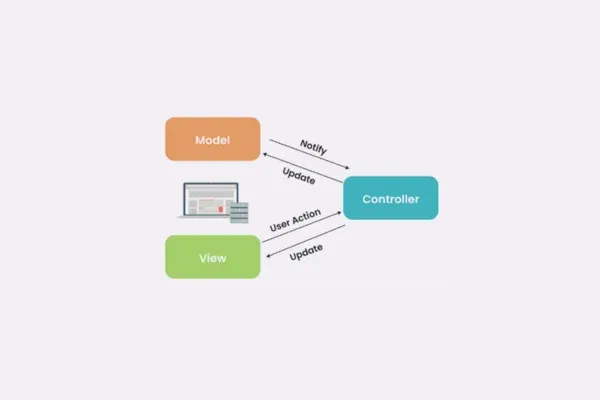 |
| Understanding MVC Architecture: A Guide to the Model-View-Controller Framework |
The MVC Architecture—standing for Model-View-Controller—is a popular design pattern in software development that separates the structure of an application into three distinct components: Model, View, and Controller. This structure enhances code organization, makes development more manageable, and improves scalability, making it an essential framework for developers working on web and mobile applications. This article will break down each component of MVC, highlight its advantages, and explain how it contributes to streamlined, maintainable code.
What Is MVC Architecture?
The Model-View-Controller (MVC) architecture is a design pattern that divides an application’s code into three main interconnected parts:
- Model: Manages the data and business logic.
- View: Displays data and handles user interaction.
- Controller: Acts as a mediator, handling requests, updating the model, and choosing the view for the user.
Each component is responsible for specific functions within the application, making the MVC architecture highly organized and suitable for collaborative development.
Breaking Down the MVC Components
1. Model: Data Management and Logic
The Model in MVC is responsible for managing the application’s data and implementing business logic. It defines the data structure, connects with the database, and processes the data needed by the application. Any updates to data are made within the Model, which then notifies the View to update the user interface.
For example, in an e-commerce application, the Model might handle customer data, inventory details, and order processing.
Key Functions of the Model:
- Fetching and storing data from the database.
- Processing business logic (e.g., calculating total costs, applying discounts).
- Updating data when requested by the Controller.
2. View: User Interface and Presentation
The View is responsible for presenting data to the user in a format that is easy to understand. It’s the front-end interface of the application, enabling users to interact with the app visually. The View retrieves information from the Model and presents it, adapting based on user input.
Using the same e-commerce example, the View would display the product catalog, shopping cart, and order summary to the user.
Key Functions of the View:
- Displaying data from the Model to users.
- Collecting user input (e.g., button clicks, form submissions).
- Updating in real time when data in the Model changes.
3. Controller: Interaction and Flow Control
The Controller functions as a bridge, managing interactions between the Model and the View. It processes user requests, manipulates the Model based on those requests, and updates the View accordingly. When the user interacts with the View (for example, by clicking a button or submitting a form), the Controller interprets the input and decides what should happen next.
In our e-commerce application, the Controller would handle actions like adding items to a shopping cart, checking out, or updating account information.
Key Functions of the Controller:
- Handling user inputs and interactions.
- Updating the Model based on user actions.
- Coordinating with the View to display the appropriate data.
Benefits of Using MVC Architecture
- Separation of Concerns: MVC clearly divides the application into three components, making it easier to manage and update without disrupting the whole system.
- Scalability: Since each component operates independently, developers can scale parts of the application without modifying the entire codebase.
- Improved Collaboration: MVC allows multiple developers to work simultaneously on different parts of the application (e.g., front-end and back-end), reducing development time.
- Reusability: The Model, View, and Controller can be reused across multiple parts of an application, saving time and effort in building similar components from scratch.
- Maintainability: With each component serving a specific role, the application is easier to debug and maintain.
How MVC Architecture Works Together
In a typical MVC flow, the application starts with a user request. Here’s a step-by-step example to illustrate how the components work together:
- User Action: The user interacts with the View, such as clicking a button to submit a form.
- Controller Processing: The Controller captures this input, processes it, and decides the necessary actions (e.g., updating a record in the database).
- Model Update: If the Controller needs to retrieve or change data, it communicates with the Model.
- View Update: Once the Model is updated, it notifies the View, which then displays the new data or state to the user.
This process is seamless, with each component fulfilling its role independently while ensuring that data flows smoothly throughout the application.
Implementing MVC Architecture in Web Development
MVC is widely used in web development frameworks such as Ruby on Rails, Django (Python), Laravel (PHP), and ASP.NET (C#). For JavaScript, libraries and frameworks like AngularJS and React (with additional libraries) can help implement MVC principles to manage complex applications.
In a Node.js application, for example, Express can serve as the Controller, handling routes and processing user requests, while databases like MongoDB or MySQL act as the Model.
Tips for Effective MVC Implementation
- Keep the Controller Lightweight: Focus on using the Controller to manage interactions and leave data processing to the Model.
- Use Separate Files for Each Component: Organize the Model, View, and Controller in distinct folders for clear separation and easier debugging.
- Implement Security Measures in the Model: Place sensitive operations in the Model to keep data secure and away from the View.
- Optimize the View for User Experience: Keep the View responsive and intuitive, making it easy for users to interact with the application.
Final Thoughts
The MVC Architecture is a tried-and-true pattern that brings structure and clarity to application development. By organizing the application into Model, View, and Controller layers, developers can build scalable, maintainable applications with ease. Whether you’re working on a simple app or a complex enterprise-level solution, implementing MVC principles can significantly streamline your development process and improve the overall user experience.
By understanding the core concepts and benefits of MVC, you’ll be better equipped to design applications that are not only efficient but also adaptable to future growth and change.
